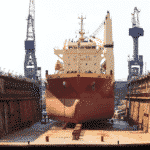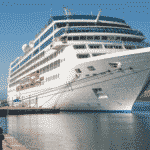5 Methods Of Medevac at Sea
Medevac or medical evacuation is a method of recusing a person at sea in times of emergencies.
On ships, an emergency can occur at any time when at sea. Though as seafarers we’re all trained for emergency situations with regular drills, with limited resources, shore assistance may be needed (depending on the severity of the situation) for rescuing (medevac) or evacuating ship personnel(s) following a medical emergency.
Different Methods of Medevac At Sea
Though usually, Medevac means rescue by air, it can be carried out in a couple of ways depending on the situation.
Below are some common methods for personnel evacuation or medevac from a ship at sea:
1. Hi-Line Medevac Technique – Hi-Line Means a Hi-Line/Heaving in Line
It is used for helicopter rescue operations when it is not possible to lower helicopter for medevac, crew members on board mainly because of weather conditions. In such situations, a Hi-Line is lowered to reduce the swing of the hoisting line.
Deck party must be briefed in advance regarding the correct handling of hi-line. Major precautions – deck party must be suitably attired, wearing gloves and lifejackets along with correct personal protective equipment (PPE).
Related Read: 10 Important Points For Safe Helicopter Operations Onboard Ships
Hi-Line must not be made fast to the vessel and must be coiled into a bucket or similar arrangement. Also, the crew must not get themselves entangled with the line.
A wire/earthing lead/hook will be connected for discharging the static; this must be allowed to touch the deck. Hi-Line must be held firmly, this will minimize swing. At all times medevac instructions from the helicopter must be followed.
Emergency equipment must be kept ready on-site and all loose gear on deck well secured or removed from location to avoid accidents from helicopter downdraft.
During night time, the deck must be suitably and sufficiently lit, ensuring that there is no glare, which can affect the pilot’s vision. Flag and pennants must be displayed, to give helicopter pilot an indication of the wind direction.
2. Helicopter Winching Medevac
When weather permits, this is the most preferred method for medevac because minimum assistance is needed from the ships’ crew. As the helicopter staff is in full control of operations, the process requires hardly any space and can be undertaken on all ship types.
For this, a winch-man is lowered onto the ship for taking care of on-site coordination and evacuation. Evacuation will generally be by means of a strop or rescue basket.
Related Read: What is Helicopter Underwater Escape Training (HUET)?
As in all helicopter operations for a medevac at sea, the pilot’s instructions must be followed at all times. Depending on the level of skills or experience some pilots will not mind vessel changing course and speed as this may be needed if the operation is taking place in an area of heavy surface traffic.
However, it is always better to inform of such manoeuvre in advance. Also, regular VHF broadcasts must be made to keep other traffic in the vicinity up to date.
Conventionally, a pilot will be sitting on the right-hand seat so the helicopter will approach from the port quarter of the vessel.
Nowadays, because of convenience and time saving, this winching method is being increasingly used for pilot/deep-sea pilot boarding in some ports.
Related Read: Important Pilot Transfer Arrangements And SOLAS Requirements For Ships
3. Rendezvous at Sea
For this method of medevac, a rendezvous is planned at sea when there is a ship with better medical facilities in the vicinity or further transportation is to be done on another ship.
In case of rendezvous with a naval vessel, more often then not, our own vessel will have to steer at an instructed course at the best available speed, while the naval ship will work out intercept course and speed for the meeting as soon as possible.
Once both vessels are in proximity, transfer of personnel will have to be done by ships’ lifeboat.
Related Read: Types of Lifeboat Release Mechanisms & SOLAS Requirements for Lifeboats
For the transfer of personnel, it would be best to use the lee side accommodation ladder. This will minimize discomfort, which may be experienced if lifeboat is launched with the casualty inside.
If a naval vessel comes for assistance during medevac, they would prefer to use their own RHIB for the purpose. Sometimes it is preferable to examine the patients’ condition so that the most efficient means of evacuation can be worked out.
4. Medevac Using Fast Rescue Boats
These are maintained for emergency evacuation by various ports in some coastal states and are available for transferring personnel to shore facilities when in coastal waters or when the vessel is within their area of operation.
Information regarding availability can be checked with local rescue coordination centres.
Coordination for medevac and transfer to shore ambulance is generally taken care of by local harbour authorities.
Related Read: 3 Important Man Overboard Recovery Methods Used At Sea
5. Helicopter Landing Medevac
This Medevac method is not discussed in detail as it is possible on only a few commercial ship types (generally large oil tankers and gearless bulk carriers) and is therefore not commonly used. ICS guide to helicopter ship operations and IAMSAR Volume III provide excellent information on this subject.
Some points to consider during Medevac:
- When evaluating a patient, at the very least, passport and/or other identity documents accompanied by available medical history, present condition and treatment given so far must also be sent along
Related Read: 7 Dangerous Diseases/Disorders Seafarers Should Be Aware Of
- Though time is of utmost importance, a risk assessment must be done prior to undertaking MEDEVAC, this will ensure smooth operations and safety of all parties involved
- Prior to operations, a suitable checklist need to be used to avoid oversight or omission as these are not routine operations, most of the companies have such checklist in their SMS otherwise it can be obtained from MGN 325 or above-mentioned publications.
- Communication with the helicopter must be such that both parties can understand clearly during MEDEVAC operation. In some countries in case of language difficulties, local SAR authorities will relay the message to and fro, the same will be the case with some international naval ships
- Onboard communication can be hampered due to noise from helicopter engine/rotors and this needs to be taken into account when planning operations.
As mentioned at the beginning of the article, seafarers are all trained and practice regularly during drills onboard. These drills must also include helicopter-ship operations to improve crew knowledge and response.
Over to you..
Do you know any other medevac method?
Let’s know in the comments below.
Related Read: How Can Ship Master Deal With Unprescribed Drugs On Ships?
Disclaimer: The authors’ views expressed in this article do not necessarily reflect the views of Marine Insight. Data and charts, if used, in the article have been sourced from available information and have not been authenticated by any statutory authority. The author and Marine Insight do not claim it to be accurate nor accept any responsibility for the same. The views constitute only the opinions and do not constitute any guidelines or recommendation on any course of action to be followed by the reader.
The article or images cannot be reproduced, copied, shared or used in any form without the permission of the author and Marine Insight.
Latest Shipboard Guidelines Articles You Would Like:
Do you have info to share with us ? Suggest a correction
Subscribe To Our Newsletters
By subscribing, you agree to our Privacy Policy and may receive occasional deal communications; you can unsubscribe anytime.
Web Stories

About Author
Capt. Ashish Joshi is presently a sailing master on container ships with a passion for teaching. At one time in his career, he used to hold classes in his ship cabin for ratings who wanted to work towards the certificate of competency! During leave, he spends time with family and on the golf course.

























